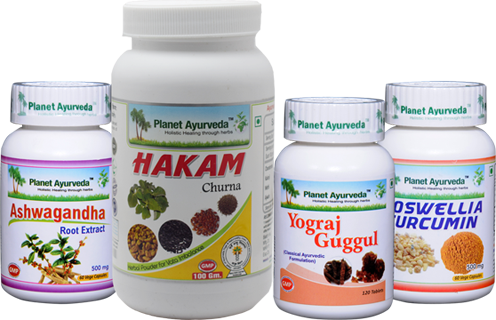How to Manage Trigeminal Neuralgia Naturally with Ayurveda
Abstarct
The human body has 12 cranial nerves originating from the brain and sending electrical signals to the head, face, neck, and torso. Cranial nerves also share information from our brain to the sense organs. The fifth pair of nerves is called the Trigeminal Nerve, which is also the largest cranial nerve. It helps in controlling chewing, movement of our teeth, jaw, and sensations in the ear muscles. It arises from 3 sensory and one motor nuclei in the brainstem and then extends into the midbrain and the medulla. It has three major branches that arise from the trigeminal ganglion, i.e., ophthalmic, maxillary, and mandibular nerve. Compression of this nerve can lead to various disorders. One such disorder is Trigeminal neuralgia, which is characterised by the severe recurrent facial pain.
Introduction
Trigeminal neuralgia is a neurological condition that causes intense, episodic facial pain. It is often referred to as one of the most excruciating conditions in medicine. People suffering from Trigeminal Neuralgia experience sharp, stabbing pains that can last from seconds to minutes, triggered by everyday activities such as speaking, chewing, or even touching the face. The pain can be so severe that it significantly affects a person’s quality of life. It is often seen in middle-aged and older adults. The exact cause of Trigeminal Neuralgia is unknown, but it is often associated with the vascular compression of the nerve.

Causes
Trigeminal neuralgia is primarily caused by irritation or compression of the trigeminal nerve, which can happen because of the following reasons:
- Vascular Compression: The blood vessels put pressure on the trigeminal nerve, disrupting its function and causing pain.
- Multiple Sclerosis: It is an autoimmune condition where our body attacks the protective covering of nerve fibers, i.e., the myelin sheath is damaged. When the demyelination of this nerve occurs, it causes abnormal signaling leading to pain.
- Tumors: Like schwannomas, brain tumors can compress the trigeminal nerve.
- Aneurysms or other Arterio-Venous malformations can also cause build up of pressure on the trigeminal nerve, causing neuralgia.
- Age-related Nerve Changes: As the individuals age, changes in our nerves occur, which can cause nerve irritation and neuralgia.
- Facial Trauma: Blunt trauma or injury to the face.
- Any oral or sinus related surgery, maxillo-facial surgery can injure the trigeminal nerve.
- Congenital Malformations: like Dandy-Walker Malformation.
Triggers
This pain can get triggered easily by the slightest things like:
- Touch: e.g., applying makeup, shaving, etc.
- Chewing or Eating: Chewing food on the side of the affected nerve will aggravate the pain.
- Talking: Speaking, or talking loudly with force, can induce pain.
- Wind or temperature changes: e.g., a cold breeze hitting the face can jolt an episode of pain.
- Brushing your Teeth: Even slightly hard bristles can trigger the pain.
- Stress: Any kind of mental or emotional stress can trigger the pain.
Types
- Classical TN: It is the most common type of TN. In this, the pain is felt on one side of the face. Pain can be triggered by the slightest things like talking, eating, brushing, etc.
- Secondary TN: TN when caused by any other underlying condition like sclerosis, tumors, schwannomas, etc. This pain is felt on both sides of the face. It is more common in young people.
- Idiopathic TN: Here the cause remains unknown, even after exhaustive diagnosis.
Also classified as
- Episodic TN/ Typical TN: Pain comes in the form of episodes lasting from a few seconds to a few minutes.
- Constant TN/ Atypical TN: Here the pain is constant and is aching, stabbing, and burning in nature.
Symptoms
- Facial pain: usually localized to one side of the face, involving the cheeks, the lower jaw, or the forehead. The episode of pain can even last for a few minutes and is often described as stabbing or an electric-shock.
- Spontaneous pain: Pain can arise suddenly in the presence of stimuli.
- Facial Twitching: Facial muscle spasms or twitching is seen on the affected side.
- Sensitivity is heightened on the side of the affected nerve.
- Pain can come in the form of episodes of short duration, followed by periods of remission.
Diagnosis
Diagnosing Trigeminal Neuralgia involves a systematic, detailed medical history, neurological examination, and some imaging to rule out the potential cause of facial pain.
- Clinical evaluation: All your symptoms including duration, intensity, location and triggers of pain are assessed.
- MRI or CT Scan: to rule out vascular compressions or tumors. MRI can help reveal findings like demyelination of nerve fibers.
- Electro-diagnostic techniques like nerve conduction studies, EMG (electromyography), Blink reflexes, Jaw reflexes, and Masseter reflexes are monitored to evaluate the functioning of the trigeminal nerve.
Treatment
- Medications:
- Tricyclic Anti-depressants: Used in cases of persistent pain.
- Anticonvulsants: drugs like carbamazepine, oxcarbazepine, are used to reduce nerve excitability.
- Muscle Relaxants: To reduce pain.
- Surgery:
- Rhizotomy: Severing of nerves to block pain transmission.
- Stereotactic Radiosurgery: radiation is used to damage the nerve & pain reduction.
- Microvascular decompression: the blood vessels which are compressing the trigeminal nerve are repositioned.
- Nerve block injections under the guidance of USG using steroids or local anaesthetics provide temporary pain relief.
- Try to avoid triggers, manage stress levels, use gentle oral cleansing tools, and use warm compresses to relieve pain.
Ayurvedic Overview
As per Ayurveda, Trigeminal Neuralgia is co-related with Anantvata. Anantvata has presence of all the three doshas with predominance of vata. That is why there is a severe intense pain in anantvata. The word Anantavata is formed of 2 words, which are “Ananta” meaning endless and “Vata” meaning vata dosha. So the “Endless Vata” significantly implies extreme sharp and long-lasting pain.
गण्डस्य पार्श्वे तु करोति कम्पं हनुग्रहं लोचनजांश्च रोगान् ||14||
In Anantvata, the vata gets lodged into manya (mandible) and Ghata (the two nerves on the backside of the neck) causing violent pain there, which ultimately affects the areas of hanu (jaw), and shira (temporal region of the head ), causing teevra ruja (throbbing pain in cheeks) and kampa in hanugraha (clenching pain in mandible which can even causes locked jaw). ]
The most effective treatment in Anantvata is “Sira-vyadhan” i.e., puncturing of veins. The diet is specifically given to balance the vitiated vata and pitta dosha. The diet should contain milk products, cow’s ghee, butter, wheat products, sugar, etc.
Various panchkarma procedures like Ksheer Dhooma (milk vapours) with Bala (Sida cordifolia) & Dashmoola (vata pacifying 10 herbs), Abhyanga with Nimbamritaddi Tailam or Rasnaadi Tailam, Mukha Lepa (application of medicated paste on affected side of the face)with lodhradi lepa, Jalouka-avcharan (leech therapy), Agni karma (thermal cauterization) are advised in Anantvata to reduce the vata dosha which is the main causative factor of sharp pain. Ksheerbala Tailam is used for Marsha nasya (nasal drops with medicated oil), Shiro pichu (a cotton pad soaked with medicated oil is placed on the head), and Matra Basti (medicated enema).
Herbal Remedies for Trigeminal Neuralgia by Planet Ayurveda
Planet Ayurveda provides a combination of ayurvedic herbs for the management of Trigeminal neuralgia. With the use of the above-mentioned herbs, planet Ayurveda has compiled the “Trigeminal Neuralgia Care Pack”. This pack includes Boswellia curcumin, Hakam churna, Ashwagandha capsules and Yograj Guggul. All the Planet Ayurveda medicines are 100 % natural, vegetarian, additive free, chemical & preservative free and without any side effects. With Ayurvedic intervention, the Trigeminal neuralgia can be managed efficiently and thus increasing the quality of life.
Product Description
1. Boswellia Curcumin
These capsules are made using a standardized extract of Shallaki (Boswellia serrata) and Haridra (Curcuma longa). The “Frankenstein oil” found in Shallaki and the primary active compound, Curcumin, in Haridra both possess strong anti-inflammatory properties, making them effective in both alleviating pain and enhancing mobility.
Dosage: 2 capsules twice daily with warm water, after meals.
2. Hakam Churna
This is available in the form of churna, which is prepared from the standardised extract of four herbs that are Chandrashoor (Lepidium sativum), Kalonji (Nigella sativa), Methi (Trigonella foenum graecum), and Ajwain (Trachyspermum ammi). All these herbs are of ushna veerya (hot potency) and are kapha and vata balancing in nature. This quality of these herbs helps in reducing nerve inflammation and also helps in clearing out any neural blockages, ultimately alleviating pain.
Dosage: 1 tsp. twice daily with warm water, after meals.
3. Ashwagandha Capsules
These capsules are prepared from the standardised extract of the Ashwagandha (Withania somnifera). Ashwagandha has Snighda guna (nourishing) and Laghu (light) qualities, along with Ushna veerya (hot potency). It is particularly effective in balancing the Kapha and Vata doshas, making it beneficial in conditions like fatigue, stress, and pain issues. Ashwagandha is a powerful Rasayana, which enhances vitality, promotes longevity, and boosts strength as it is Balya. Additionally, it offers anti-inflammatory and anti-bacterial properties, contributing to overall health and well-being.
Dosage: 1 capsule twice daily with warm water, after meals.
4. Yograj Guggul
Yograj Guggul is an herbal supplement in tablet form, made from the standardized extracts of Ayurvedic herbs such as Guggul (Commiphora mukul), Amla (Emblica officinalis), Haritaki (Terminalia chebula), and Vibhitaki (Terminalia bellirica). These herbs work together to help balance the body’s three doshas, with a particular focus on pacifying Vata dosha. Known for its anti-inflammatory, antioxidant, and detoxifying properties, Yograj Guggul alleviates pain, aids in maintaining a healthy metabolism, and helps resolve digestive issues. It also assists in managing conditions like arthritic pain, obesity, and respiratory concerns. Consistent use of Yograj Guggul can enhance overall vitality and strengthen the immune system of our body.
Dosage: 2 tablets twice daily with warm water, after meals.
Conclusion
Trigeminal neuralgia is a painful and often debilitating condition that affects the trigeminal nerve, resulting in sharp, electric shock-like pain in the face. While the exact cause can vary, vascular compression and multiple sclerosis are among the most common underlying conditions. Early diagnosis and appropriate treatment, including medications, surgery, and lifestyle modifications, are essential in managing the disorder and improving quality of life. Ayurveda offers a natural approach in managing pain and helps in managing the cause of the neuralgia.







